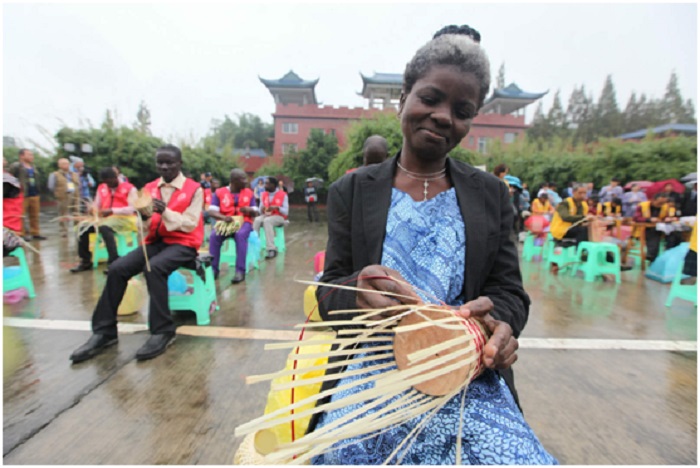



NiiNamoaley Obiba is the owner of a bambooware shop in a business street near the Kumasi Zoo in Kumasi city, Ghana. Even though the outbreak of COVID-19 led to a plunge in the number of tourists, his shop is still frequented by local residents.
Obiba makes and sells a wide range of bamboo and rattan products, such as tables, chairs, sofas and beds. He also sometimes customizes furniture as required by his clients.
According to the man, both his skills and income have been tremendously improved after he participated in a training program jointly launched by the International Bamboo and Rattan Organization (INBAR) and China.
As the first intergovernmental organization established in China, the INBAR is committed to maintain sustainable development of bamboo and rattan resources. The organization has just celebrated the 23rd anniversary of its founding on Nov.6, 2020.
As China is continuously enhancing its support for the work of the INBAR, the advanced technology and experience of its bamboo industry are being spread to the world in a faster pace. As a result, the bamboo and rattan industry is contributing an important part to promoting South-South cooperation and the construction of the Belt and Road Initiative (BRI).
George Sarpong, a friend of Obiba’s, comes from the Bono Region of Ghana, and is also a bamboo craftsman. He participated in a bamboo skill training program held by the INBAR in Qingshen county, southwest China’s Sichuan province, in 2016.
“The Chinese masters were really skillful and I learnt such techniques as 3D and 2D bamboo weaving and bamboo furniture making in just two months under their instruction,” he said. “It was such a pity that I had to leave,” Sarpong added.
Chinese bamboo craftsmen, in the past two years, made frequent visits to Ghana to offer training courses, so that local bambooware makers could master the techniques without going out of their country.
Being trained in China, Sarpong is also an instructor for local craftsmen in his hometown. “I showed the villagers how amazing bamboo is and have instructed 35 apprentices. All of them have started their own businesses,” Sarpong said. The man explained that he hopes to pass on the knowledge he learnt in China to younger generations in his own country so as to help them become able to make a living.
Like Obiba and Sarpong, many bamboo craftsmen in Africa have benefited from the INBAR training program.
Aiming to involve peasant households in Africa into the value chain of bamboo products through skill training, the program has received strong support from China.
As the bamboo industry is witnessing expanding commercial development, bamboo growers and loggers are also embracing new opportunities.
To avoid damages to the wild bamboo forests while chopping them, which might hinder the sustainable use of resources, the INBAR has drawn from the experience of China and provided forest management training in rural areas of Ghana. So far, nearly 100 peasant households in Ghana have received the training and learnt about protecting, planting, logging and managing bamboo forests.
In rural Ecuador, buildings and bridges made by Guadua bamboo are seen everywhere. The special bamboo native to South America is favorable building materials.
Last year, China launched three training sessions of bamboo processing skills for Ecuadorans, one in China, and two in Ecuador. The training was organized by the International Centre for Bamboo and Rattan (ICBR), a scientific research, management and training institution established by the Chinese government to support the INBAR in fulfilling its mission.
The Ecuadoran trainees cherished the opportunity very much and learnt earnestly.
Jose Enrique Alarcon Silva, who was almost 60 years old and engaged in tourism services, had to spend four hours a day on the road to the site of the training.
When asked why he invested so much time in learning bamboo weaving skills, he responded that the bamboo business was a great opportunity to thicken his pockets. “I have benefited a lot from what the Chinese experts had shared with us,” he said.
When the training was about to conclude, the man who had never missed a single course asked for two days off. It turned out that he received an order of 500 bamboo bags, and needed to sign a deal with the buyer.
Due to the pandemic this year, Chinese experts haven’t been able to continue with offline training projects in foreign countries. However, they have kept close online communication with overseas trainees and answered their questions about bamboo weaving skills.
Since 2005, the ICBR has organized 52 sessions of training on bamboo and rattan production, as well as desertification control, sharing with the world China’s successful experience in developing the bamboo and rattan industry. Government officials and experts from more than 80 countries have participated in the training.
Meanwhile, China has exported its bamboo shoot production, processing, and sales techniques and experience to countries like Bangladesh and Sri Lanka, and established a system for developing and marketizing prefabricated bamboo houses worldwide and promoted the large-scale application of bamboo resources in environment-friendly houses.
It has also taken the lead in establishing the Bamboo and Rattan International Organization for Standardization (ISO) Technical Committee, advanced the international standardization of bamboo and rattan industry, and facilitated global bamboo and rattan trade.
The green bamboo and rattan industry is serving as a bridge for South-South cooperation and driving the construction of a more beautiful world.


The Humanitarian Service Diamond Awards has.
A Chinese Company, Inner Galaxy Steel.


The Programme Coordinator, Regulatory, Compliance and.


A Non-Governmental Organization (NGO), Committee for.
The Trustfund Pensions Limited has chided.


The House of Representatives Committee on.
The China General Chamber of Commerce.


Senator Chuka Utazi who represented Enugu.


An Abuja based Legal Practitioner, Ugochukwu.


The African business community in Yiwu,.
Leave a Comment